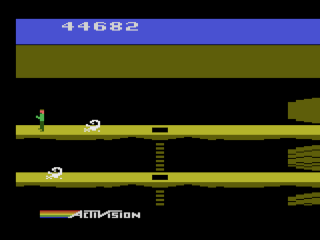|
|
Pitfall II: The Lost Caverns
|
Name:
|
Pitfall II: The Lost Caverns |
 |
| Company: | Activision | |
|
Model #:
|
AB-035-004 | |
|
Programmer:
|
David Crane |
|
| Year: | 1984 | |
|
Released?
|
Yes
|
|
|
Notes:
|
The 2600 version uses a special Display Processor Chip (DPC) |
When developing a sequel to a smash hit, the expectations are
high. Not only does it need to be as good as an already
amazing game, but it needs to add new gameplay elements that
take the game further. This would be a daunting task for
most programmers, but thankfully David Crane hit it out of the
park. Again! Pitfall II takes the same basic
gameplay ideas from the first game (run, jump, explore, grab
treasure) and improves on it by giving the player a huge new
world to explore with a story and an actual goal to accomplish.

Once again you play the role of Pitfall Harry, famed explorer and track and field star (check out Decathlon if you don't believe me). This time around however you're not exploring an endless jungle, instead Harry must explore a giant cavern in an attempt to rescue his niece Rhonda, his pet lion Quickclaw, and find the legendary Raj Diamond. While these three items are required to win the game (yes, there is an ending this time), Harry can also collect gold bars scattered randomly throughout the cavern for extra points. Harry can also grab the cave rat for extra points, but like the gold bars, it's not required to win the game.

The cavern is big, like really really big, so big
you'll never see the end of it. Ok so maybe it's not THAT
big, but it certainly seems that way to many first time players
(it's actually 27 x 8). Thankfully the cavern isn't a maze
and is actually pretty straight forward. Once you get into
it from the above ground section (this is a one way trip BTW),
you'll find the cavern separated into three distinct sections,
each with little side tunnels to explore. The first
area is the a long series of ledges connected by a single
ladder, the second area is a large open area that must be
explored by grabbing a balloon which will let you float upwards,
while the third area is a long slog upwards through a gauntlet
of scorpions, condors, and bats. The first area only has
gold bars so it can be quickly run through if you're not
interested in points, the second area contains Rhonda and the
Raj Diamond. This area requires some leaps of faith off
cliffs and can be a little confusing. Quickclaw and the
rat await you at the top of the third area.

Scattered throughout the cavern are odd looking
red crosses. Touching one of these will act as a save
point and if Harry is ever hit by an enemy he will automatically
fly back to the last cross he touched. The only penalty
for dying is a loss of points (you lose more points the further
Harry has to travel back to the cross), but you may do this an
infinite amount of times even if you've run out of points.
This ingenious system allows causal players a chance to really
explore the game without fear while giving more competitive
gamers the ability to play for high score. In fact Pitfall
II may be the only 2600 game where the player actually cannot
lose!

Pitfall II brings back some old enemies and introduces some new ones as well. Scorpions will still hound Harry's every step, but this time they're joined by bats, condors, frogs, and electric eels. While condors will fly serenely across the across the screen in wide arcs, bats flutter up and down in a more jagged pattern. Each of these can be run underneath if you time it right. Frogs like to jump back and forth at the tops of ladders and can be a pain to get past if you don't time things right. Eels are only encountered in the water areas and easily avoided if Harry stays on the surface.


If Pitfall II has a flaw it's that it's winnable. There's an absolute end to the game and a maximum score than can be achieved (199,000). The difficulty never increases (not that the game really has difficulty levels anyway) and the cavern layout never changes, so once the player has masted the game the replay value diminishes dramatically. In fact an experienced player who knows what they're doing can beat the game in 10 minutes or less. The Atari 400/800 and 5200 ports solve this problem by adding a whole new second quest (which was basically a completely new game) which can be accessed after beating the game.
| Version | Cart Text | Description |
| ?/??/84 | Pitfall II The Lost Caverns
AB-035 (C) 1984 Activision,Inc. |
Final Version |
